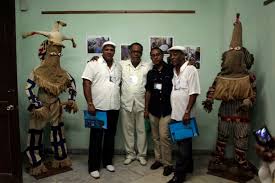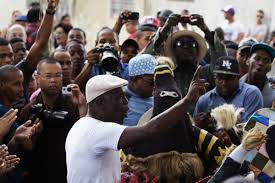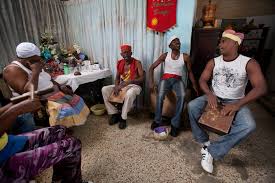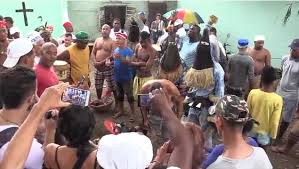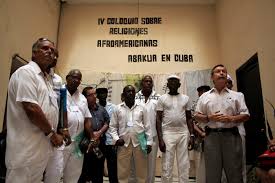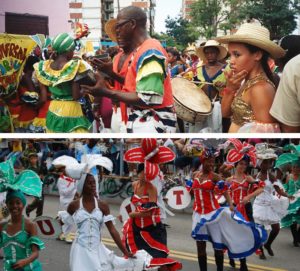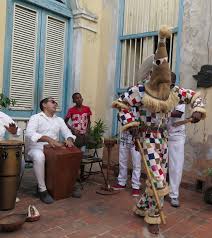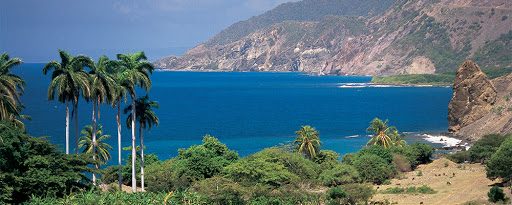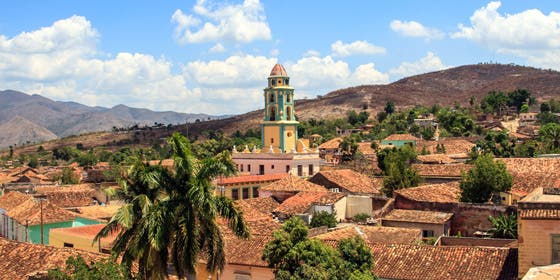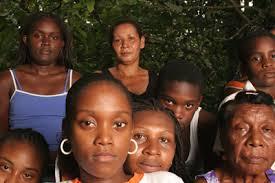 ABAKUÁ: GRUPOS AFRO-CUBANOS ÉTNICOS REPRESENTADOS EN LA ISLA.
ABAKUÁ: GRUPOS AFRO-CUBANOS ÉTNICOS REPRESENTADOS EN LA ISLA.
Nuestro famoso antropólogo Fernando Ortiz, quien fue pionero en el estudio de las culturas neoafricanas en las Américas, particularmente en Cuba, contó la presencia de más de cien grupos étnicos africanos diferentes en la Cuba del siglo XIX y estimó que para fines de ese siglo catorce distintos ” naciones “habían conservado su identidad en las asociaciones de ayuda mutua y clubes sociales conocidos como cabildos, sociedades de negros libres y esclavizados de la misma” nación “africana, que luego incluyó a sus descendientes de origen cubano.
“Toque” Abakuá.
Si bien los cabildos formalmente organizados eran un fenómeno principalmente urbano, las prácticas africanas individuales y colectivas también continuaron floreciendo en las plantaciones azucareras, conocidas como ingenios o centrales. Eran más como pequeños municipios industriales autónomos que como “plantaciones”. Aproximadamente el 80% de los recién llegados [africanos] conocidos como bozales, fueron enviados a ellos, y muchas centrales se convirtieron en centros de “naciones” africanas específicas.
Forjados en los cabildos y en medio de la agotadora labor en los ingenios azucareros, cuatro grandes divisiones afrocubanas (ABAKUÁ, LUCUMÍ, ARARÁ y KONGO) están representadas en Cuba.
ABAKUÁ.
Abakuá, también conocido como Nañigo, es una fraternidad iniciática o sociedad secreta de hombres afrocubanos, que se originó a partir de asociaciones fraternales en la región de Cross River en el sureste de Nigeria y el suroeste de Camerún.
Abakuá ha sido descrito como “una versión afrocubana de la masonería”.
Conocidos generalmente como Ekpe, Egbo, Ngbe o Ugbe entre los grupos multilingües de la región, se creía que los Ñáñigos, como se conoce a los miembros, podían transformarse en leopardos para acechar a sus enemigos. En el Haití contemporáneo, donde las sociedades secretas se han mantenido fuertes, una rama de élite del ejército que se estableció para infundir miedo en las masas inquietas se llamó Los Leopardos. Entre los actos de venganza menos místicos de Ñáñigo estaba la capacidad de entregar a la gente a los esclavistas. En África, eran operadores notorios que habían hecho tratos regulares para obtener ganancias con los esclavistas.
Se cree que el término cubano criollo Abakuá se refiere al área de Abakpa en el sureste de Nigeria, donde la sociedad estaba activa. Las primeras sociedades de este tipo fueron establecidas por africanos en la ciudad de Regla, La Habana, en 1836. Esta sigue siendo el área principal de implantación de Abakuá, especialmente el distrito de Guanabacoa en el este de La Habana y en Matanzas, donde la cultura afrocubana es vibrante.
Propagación a Florida
Las ciudades con muchos inmigrantes afrocubanos en Florida, como Key West e Ybor City, tenían una religión conocida por los observadores como “Nañigo”, a la que los practicantes se referían como “Carabali Apapa Abacua”. En la década de 1930, gran parte de la religión parecía haber desaparecido de la visibilidad.
Para que se formen las logias Abakuá se debe realizar un rito de iniciación estructurado, algo difícil de hacer para los miembros inmigrantes Abakuá que están alejados de las logias establecidas en Cuba. Por ello, existe un debate sobre si las prácticas descritas como “Nañigo” eran prácticas oficiales de Abakuá o simplemente imitaciones realizadas por miembros alejados de las logias oficiales. El término “Nañigo” en sí mismo se usó a menudo para describir cualquier tradición afrocubana practicada en Florida y, por lo tanto, no es confiable para describir ningún conjunto de tradiciones con precisión.
No se habían formado logias Abakuá en Miami hasta 1998 un grupo Abakuá declaró su existencia en Miami solo para que los miembros cubanos Abakuá lo denunciaran ya que su logia no estaba oficialmente consagrada con materiales sagrados que solo se encuentran en Cuba.
Cultura y prácticas
Los miembros de esta sociedad llegaron a ser conocidos como ñañigos, una palabra que se usa para designar a los bailarines callejeros de la sociedad. Los ñañigos, también llamados diablitos, eran muy conocidos por la población en general en Cuba por su participación en el Carnaval del Día de los Reyes Magos, cuando bailaban por las calles luciendo su atuendo ceremonial, un vestido de tablero de ajedrez multicolor con una forma cónica. tocado rematado con borlas.
Los juramentos de lealtad a los objetos sagrados, miembros y conocimiento secreto de la sociedad Abakuá tomados por los iniciados son un pacto de por vida que crea un parentesco sagrado entre los miembros. Los deberes de un miembro Abakuá para con sus hermanos rituales a veces superan incluso las responsabilidades de la amistad, ya menudo se escucha la frase “La amistad es una cosa y el Abakuá otra”. [7] Uno de los juramentos que se hacen durante la iniciación es que no se revelarán los secretos del Abakuá a los no miembros, por lo que el Abakuá se ha mantenido hermético por más de 160 años.
Ceremonia
Además de actuar como una sociedad de ayuda mutua, el Abakuá realiza rituales y ceremonias, llamados plantes, llenos de teatralidad y drama que consisten en tocar tambores, bailar y cantar en el secreto idioma Abakuá. El conocimiento de los cánticos está restringido a los miembros de Abakuá, pero los eruditos cubanos han pensado durante mucho tiempo que las ceremonias expresan la historia cultural de Abakuá. Otras ceremonias como las iniciaciones y los funerales, son secretas y ocurren en la sala sagrada del templo de Abakuá, llamada la famba.
Música
La música rítmica de baile de los Abakuá combinada con las tradiciones bantú del Congo contribuyó a la tradición musical de la rumba.
Aunque hermético y poco conocido incluso dentro de Cuba, un análisis de la música popular cubana grabada desde la década de 1920 hasta la actualidad revela la influencia de Abakuá en casi todos los géneros de la música popular cubana. Los músicos cubanos que son miembros del Abakuá han documentado continuamente aspectos clave de la historia de su sociedad en grabaciones comerciales, generalmente en su idioma secreto Abakuá. Los Abakuá han grabado comercialmente cánticos reales de la sociedad, creyendo que los forasteros no pueden interpretarlos. Debido a que Abakuá representaba un aspecto rebelde, incluso anticolonial, de la cultura cubana, estas grabaciones secretas han sido muy populares.
Religión
Los miembros de Abakuá derivan sus sistemas de creencias y prácticas tradicionales de los espíritus Igbo, Efik, Efut e Ibibio que vivían en el bosque. Ekpe y términos sinónimos eran nombres tanto de un espíritu del bosque como de una sociedad secreta relacionada con el leopardo. Gran parte de lo que creen los abacuas en términos de religión se considera un secreto que solo conocen los miembros.
Debido al secretismo de la sociedad, poco se sabe del idioma Abakuá. Se supone que es una versión criolla de Efik o Ibibio, ambos idiomas o dialectos estrechamente relacionados de la región de Cross River de Nigeria porque esta es la región cultural y los grupos étnicos donde se originó la sociedad.
The Abakuá Afro-Latin Dance Company, una compañía de danza con sede en la ciudad de Nueva York, toma su homónimo de este origen. El propósito de seleccionar este nombre era reconocer el vínculo de la compañía con los orígenes del tipo de música que la compañía también interpreta. La compañía no pretende ser una representación auténtica del estilo específico nativo de Abakuá, sino más bien una amalgama de movimientos nativos de la cultura afrocubana / caribeña y el desarrollo del estilo único de la compañía titulado Afro-Latin Funk. La selección del nombre “Afro-Latin” se hizo con el fin de identificar la presencia de la empresa dentro de la cultura latina e hispana en su conjunto.
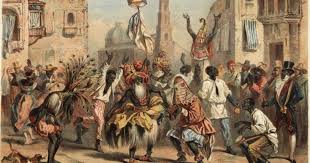 ABAKUÁ AND AFRO-CUBAN ETHNIC GROUPS REPRESENTED ON THE ISLAND.
ABAKUÁ AND AFRO-CUBAN ETHNIC GROUPS REPRESENTED ON THE ISLAND.
Our famous anthropologist Fernando Ortiz who pioneered in the study of neo-African cultures in the Americas, particularly in Cuba, counted the presence of over one hundred different African ethnic groups in 19th century Cuba and estimated that by the end of that century fourteen distinct “nations” had preserved their identity in the mutual aid associations and social clubs known as cabildos, societies of free and enslaved blacks from the same African “nation,” which later included their Cuban-born descendants.
While the formally organized cabildos were a primarily urban phenomenon, individual and collective African practices also continued to flourish at the sugar estates, known as ingenios or centrales. These were more like small, self-contained industrial townships than “plantations.” About 80% of the newly-arrived [Africans] known as bozales, were sent to them, and many centrales became centers of specific African “nations.”
Forged in the cabildos and amidst the grueling labor at the sugar mills, four major Afro-Cuban divisions (ABAKUÁ, LUCUMÍ, ARARÁ, AND KONGO) are represented in Cuba.
ABAKUÁ.
Abakuá, also sometimes known as Nañigo, is an Afro-Cuban men’s initiatory fraternity or secret society, which originated from fraternal associations in the Cross River region of southeastern Nigeria and southwestern Cameroon.
Abakuá has been described as “an Afro-Cuban version of Freemasonry”.
Known generally as Ekpe, Egbo, Ngbe, or Ugbe among the multi-lingual groups in the region, it was believed that Ñáñigos, as the members are known, could be transformed into leopards to stalk their enemies. In contemporary Haiti, where secret societies have remained strong, an elite branch of the army that was set up to instill fear in the restless masses was named The Leopards. Among the less mystical Ñáñigo acts of revenge was the ability to turn people over to slavers. In Africa, they were notorious operators who had made regular deals for a profit with slavers.
The creolized Cuban term Abakuá is thought to refer to the Abakpa area in southeast Nigeria, where the society was active. The first such societies were established by Africans in the town of Regla, Havana, in 1836. This remains the main area of Abakuá implantation, especially the district of Guanabacoa in eastern Havana, and in Matanzas where Afro-Cuban culture is vibrant.
Spread to Florida
Cities with many Afro-Cuban immigrants in Florida such as Key West and Ybor City had a religion known by observers as “Nañigo” which was referred to as “Carabali Apapa Abacua” by practitioners. By the 1930s much of the religion seemed to have disappeared from visibility.
For Abakuá lodges to be formed a structured initiation rite must be performed, something difficult to do for immigrant Abakuá members who are estranged from established lodges in Cuba. For this reason, there is a debate as to whether the practices described as “Nañigo” were official Abakuá practices or simply imitations done by members estranged from official lodges. The term “Nañigo” itself was often used to describe any Afro-Cuban traditions practiced in Florida and is thus not reliable to use to describe any set of traditions with accuracy.
No Abakuá lodges had been formed in Miami until 1998 an Abakuá group declared its existence in Miami only for Cuban Abakuá members to denounce it since their lodge wasn’t officially consecrated with sacred materials only found in Cuba.
Culture and practices
Members of this society came to be known as ñañigos, a word used to designate the street dancers of the society. The ñañigos, who were also called diablitos, were well known by the general population in Cuba through their participation in the Carnival on the Day of the Three Kings, when they danced through the streets wearing their ceremonial outfit, a multicolored checkerboard dress with a conical headpiece topped with tassels.
The oaths of loyalty to the Abakuá society’s sacred objects, members, and secret knowledge taken by initiates are a lifelong pact that creates a sacred kinship among the members. The duties of an Abakuá member to his ritual brothers at times surpass even the responsibilities of friendship, and the phrase “Friendship is one thing, and the Abakuá another” is often heard.[7] One of the oaths made during initiation is that one will not reveal the secrets of the Abakuá to non-members, which is why the Abakuá has remained hermetic for over 160 years.
Ceremony
Besides acting as a mutual aid society, the Abakuá performs rituals and ceremonies, called plantes, full of theatricality and drama which consists of drumming, dancing, and chanting in the secret Abakuá language. Knowledge of the chants is restricted to Abakuá members, but Cuban scholars have long thought that the ceremonies express Abakuá cultural history. Other ceremonies such as initiations and funerals, are secret and occur in the sacred room of the Abakuá temple, called the famba.
Music
The rhythmic dance music of the Abakuá combined with the Bantu traditions of the Congo contributed to the musical tradition of the rumba.
Although hermetic and little known even within Cuba, an analysis of Cuban popular music recorded from the 1920s until the present reveals Abakuá’s influence in nearly every genre of Cuban popular music. Cuban musicians who are members of the Abakuá have continually documented key aspects of their society’s history in commercial recordings, usually in their secret Abakuá language. The Abakuá have commercially recorded actual chants of the society, believing that outsiders cannot interpret them. Because Abakuá represented a rebellious, even anti-colonial, aspect of Cuban culture, these secret recordings have been very popular.
Religion
Abakuá members derive their belief systems and traditional practices from the Igbo, Efik, Efut, and Ibibio spirits that lived in the forest. Ekpe and synonymous terms were names of both a forest spirit and a leopard related secret society. Much of what the Abakua believe in terms of religion is considered a secret only known to members.
Due to the secrecy of the society, little is known of the Abakuá language. It is assumed to be a creolized version of Efik or Ibibio, both closely related languages or dialects from the Cross River region of Nigeria because this is the cultural region and ethnic groups where the society originated.
The Abakuá Afro-Latin Dance Company, a dance company based in New York City, draws its namesake from this origin. The purpose of selecting this name was to recognize the company’s link to the origins of the type of music the company performs too. The company does not claim to be an authentic representation of the specific style native to Abakuá but rather, an amalgamation of movements native to Afro-Cuban/Caribbean culture and the development of the company’s own unique style entitled Afro-Latin Funk. The selection of the name “Afro-Latin” was done in order to identify the company’s presence within Latin and Hispanic culture as a whole.
Agencies/ Wiki/ R. Guerra/ Internet Photos/ Internet Photos/ YouTube/ Arnoldo Varona/ www.TheCubanHistory.com
THE CUBAN HISTORY, HOLLYWOOD.



 ABAKUÁ: Grupos Afro-Cubanos Étnicos Representados en la Isla. VIDEOS.
ABAKUÁ: Grupos Afro-Cubanos Étnicos Representados en la Isla. VIDEOS.